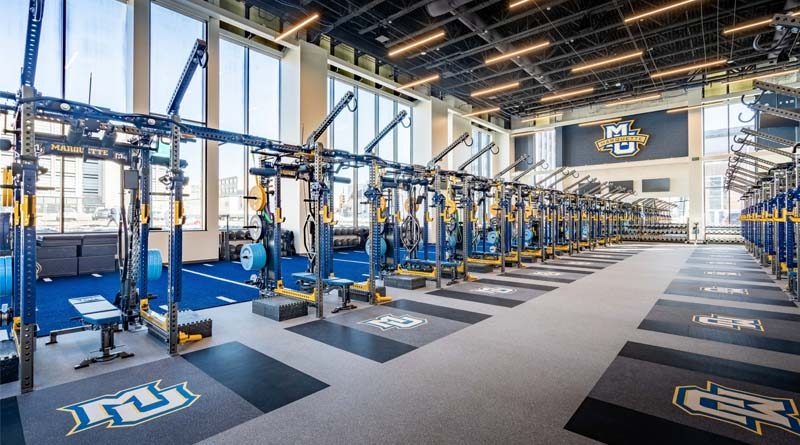First Phase of Wisconsin Athletic Performance Research Center Now Open
By Lisa Kopochinski
MILWAUKEE, Wis.—Earlier this year, a dedication ceremony was held in Milwaukee, Wisc. for the first phase of Marquette University’s new $24 million Athletic and Human Performance Research Center (AHPRC).
The 46,000-square-foot innovative multi-purpose facility is the new permanent home for men’s and women’s lacrosse and men’s golf, and combines training, testing and research all under one roof. It also integrates athletics and research to develop new fitness technologies and advance the use of data analytics to improve performance and include those of athletes with special needs.
The first phase of this project was designed by architecture and design firm Perkins and Will and multidisciplinary design firm HGA Architects. Mortenson Construction is the general contractor on this project.
There was an urgency in that in their six years of existence, the men’s and women’s lacrosse teams have been without permanent locker room space. This new facility has given Marquette a competitive advantage for recruiting, according to Christopher Stolarski, Associate Director of University Communication. Player development and program culture have been enhanced by combining locker, office and training facilities, with key fitness research being conducted onsite.
Additionally, the AHPRC launched a pilot award program designed to facilitate and foster collaborative health- and performance-related research between disciplines. The first four pilot award winners were announced recently. Projects focus on stroke rehabilitation, diabetes, student-athlete injuries and concussion recovery.
“Our team has approached Phase 1 with a focus on refined design, high-caliber building materials, appropriate site use, and preparing the AHPRC for future expansion,” explains Lindsey Peckinpaugh, leader of Perkins and Will’s Sports, Recreation, and Entertainment practice in the Chicago studio.
“We view this as a project that will allow Marquette to serve unmet needs of its athletic program and advance the university’s commitment to research on athletic and human performance,” she adds.
This first completed phase includes space for faculty researchers, locker rooms and support space for lacrosse and golf teams, and strength and conditioning space for the athletic department. It also includes a team film room, and research and bio-assessment labs.
“Our partnership with Perkins and Will and HGA brought to bear a facility that does something truly unique in bringing together under the same roof an elite Division I NCAA athletics program and world-class researchers in human performance, rehabilitation and exercise science,” says Lora Strigens, Marquette’s vice president for planning and facilities management.
“Every step of the way, our design partners took great care to understand the needs of our student athletes, our researchers and how to create synergies between the two,” she adds.
The biggest project challenge so far has been from a design perspective. Peckinpaugh says a significant driver in this project was the need to meet aggressive speed-to-market demands.
“This resulted in phasing the project to deliver new athletic spaces as quickly as possible, which kept the project moving efficiently; minimizing disruption while balancing the needs of the research program and all sport and strength conditioning spaces.”
With the interior design, Stolarski says it was important to “meld” the aesthetics and branding surrounding the building’s athletic and research components.
“Utilizing a refined finish palette allowed both program components to interweave into the overall building design, and complementary branding design elements to contribute to the ‘wow’ factor for both athletics and research,” he explains.
“Phasing also influenced the architectural design as well, as it became critically important to ensure that Phase 1 felt completed, but also allowed for seamless integration with future phases,” adds Russell Wilson, project architect with HGA, who led the exterior design and served as associate architect and structural engineer of record.
“The design team resolved this challenge through the use of strong vertical rhythm and exterior features, such as sunshades and horizontal projections, and by borrowing from the material palettes of other campus buildings,” he says.
Key features of the impressive project include:
- Branded lockers for the players, customized for each sport.
- A customized engagement process that prioritized the input of players, coaches, researchers.
- A tailored approach to this facility which sets it up for easy phasing in the future.
- A team film room where teams and coaches can have larger meetings or review game and practice films.
- Generously daylit strength and conditioning space that coaches call a “game changer.” This space includes a turf area and cardio mezzanine that overlooks the entire space.
- Nutrition options to aid in post-workout recovery.
- Research and bio-assessment labs to analyze athlete fitness and training data, with the goal to improve performance and training methods in both Athletics and other programs.
The AHPRC is part of a long-term master plan that will be built in phases. Perkins and Will, HGA and Marquette are currently discussing what elements may be in the second phase of the facility. Marquette University will also continue to address the needs of its athletic program and be responsive to research growth over time.

